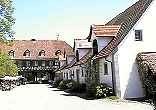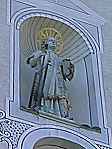SWITZERLAND
ITTINGEN
|
|
ALL ABOUT SWITZERLAND |
|
KARTAUSE ITTINGEN |
||||
All About Switzerland

|
Kartause [Charterhouse] Ittingen, a former monastery 4 km [2.5 miles] north of Frauenfeld, northeastern Switzerland has become an important centre of fine arts in the region hosting Thurgau's Cantonal Museum of Fine Arts. Besides, the property features a conference center, hotel, restaurants, banquet facilities, a religious retreat centre of the Reformed Church, rose, herb and hops gardens and a residence for handicapped people. They work in the property's own farm and wineyard, dairy, beer brewery, pottery, hotel and restaurant. Agriculture serves mainly the property's own restaurants, a small part is sold in a little shop. Artists and writers may stay for free in one of the former monks cells provided they produce one work that incorporates the Kartause. |
| 1084 | The Carthusian Order is founded by St Bruno at Chartreuse, France. |
 St Laurentius patron of the church in Ittingen used to be highly venerated in the Frauenfeld region during the middle ages. |
| 1150 | Ittingen is founded by the local nobility as an Augustinian monastery. | |
| 1461 | Ittingen is sold to the Carthusian Order and adopts their specific rule of religious life. Carthusian monks live in individual cells where they spend most of their time in solitude much like hermits. These cells are characteristic for Carthusian architecture. The monks do join together several times a day for singing and prayers in the church and for dinner on Sundays, however. | |
| 1524 | The charterhouse of Ittingen is destroyed during the disorders of the Swiss Reformation. While monasteries remain closed in the areas of Switzerland dominated by the cities of Zurich, Bern, Geneva, Basel and Schaffhausen, monasteries in Aargau and Thurgau (areas under joint administration by catholic cantons of central Switzerland and reformed cities) are soon restored for some centuries. | |
| 1798 | During the Swiss Revolution (1798 - 1815) monasteries all over Switzerland are not allowed to accept novices. | |
| 1848 | 19th century liberalism, particularly strong in cantons Aargau and Thurgau, clashes with the churches' determination to play a dominating rôle in politics. In Switzerland the formation of a modern, democratic federal state and the political struggle between liberal politicians and the churches [Kulturkampf] are closely intervowen. So the victory of the liberals over the conservatives in the civil war of 1847 leads to the secularization [abolition] of monasteries in canton Thurgau in 1848. Kartause Ittingen is run as a state owned farmyard for some years. | |
| 1867 | Kartause Ittingen is sold to a local family and used for 110 years as a farm. | |
| 1977 | A non-profit association "Kartause Ittingen" is founded and takes over to preserve the buildings from decay. | |
| 1979 to 1983 | Complete restauration of the buildings. The cantonal museum of fine arts of canton Thurgau moves in. A guesthouse is added so that the site can be operated as a culture and congress centre. The agricultural facilities serve as suppliers to the hotel restaurant. |
| Regional Art | Outsiders / Naive Art | Contemporary Art | |
|---|---|---|---|
For a long period, public activity in fine arts by the cantonal authorities was orientiented on a territorial principle. Occasionally works of regional artists were acquired to support them and to document "native creativity". Outstanding in this group are Adolf Dietrich, a naive painter from Berlingen (Bodensee) and Helen Dahm, an expressionist and tachist painter who spent her childhood in Kreuzlingen (Bodensee).
|
Based on the unique group of works by regional painter Adolf Dietrich and his importance in Naive Art, the cantonal museum of fine arts began to build up a collection of works by Swiss and international outsiders in art in the 1960's - a field in fine arts that most other Swiss museums of art pay less attention to. The museum administrates the estates of Adolf Dietrich and Hans Krüsi.
|
Outstanding regional artists do still play an important rôle in recent acquisitions of the museum. Since 1995 works of foreign artists are being collected, too, if they take up and interpret the special ambiente of Kartause Ittingen. | |
|
|
||
| Winter | October, 1st to March, 31st | Monday through Friday | 2 p.m. to 5 p.m. |
| Saturdays/Sundays/public holidays | 11 a.m. to 5 p.m. | ||
| Summer | April, 1st to September, 30th | Monday through Friday | 2 p.m. to 6 p.m. |
| Saturdays/Sundays/public holidays | 11 a.m. to 6 p.m. |
|
Online timetable, enter any starting point within Switzerland,
answer will be provided by Swiss Federal Railways
in a separate window:Online Timetable |

Unfortunately, almost all really significant websites and publications on Kartause Ittingen are only available in German, the official language of the region.
The links presented below point to pages with paintings by Adolf Dietrich.
The links presented below point to pages with many pictures that give a good impression of what kind of paintings you can expect if you plan a visit. If links are broken, please try the domain's homepage. (Helen Dahm Society, Oetwil am See)

Short quotations allowed but with precise declaration of origin (Link).
Reproduction of substantial parts and pictures in printed or electronic form
only with explicit written consent by the editor.
| Disclaimer | Privacy Policy | www.all-about-switzerland.info © 2005-2010 All Rights Reserved | Editor | ||